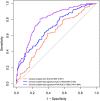A panel of blood lipids associated with cognitive performance, brain atrophy, and Alzheimer's diagnosis: A longitudinal study of elders without dementia
- PMID: 32995461
- PMCID: PMC7507431
- DOI: 10.1002/dad2.12041
A panel of blood lipids associated with cognitive performance, brain atrophy, and Alzheimer's diagnosis: A longitudinal study of elders without dementia
Abstract
Introduction: We sought lipid-metabolic biomarkers involved in the processes underlying cognitive decline and detected them in association with Alzheimer's disease (AD) phenotypes.
Methods: A least absolute shrinkage and selection operator logistic regression model was used to select lipids that best classified cognitive decline defined by a fast-annual rate of cognition. Lipid summary scores were constructed as predictors of cognitive decline by using this model. Multivariable-adjusted models tested the associations of risk score with AD phenotypes.
Results: A model incorporating 17 selected lipids showed good discrimination and calibration. The lipid risk score was positively associated with the baseline Alzheimer Disease Assessment Scale-13-item cognitive subscale (ADAS-Cog13) score and cerebrospinal tau protein level, and predicted cognitive diagnoses. Additional results showing that individuals with increased lipid risk scores had rapid change rates of ADAS-Cog13 and brain atrophy further corroborated the predictive role of lipids.
Discussion: A panel of blood lipids instead of individual lipid molecules could better diagnose and predict cognitive decline.
Keywords: biomarkers; cognitive decline; lipidomics; prediction.
© 2020 The Authors. Alzheimer's & Dementia: Diagnosis, Assessment & Disease Monitoring published by Wiley Periodicals, Inc. on behalf of Alzheimer's Association.
Conflict of interest statement
The authors have no conflicts of interest to disclose.
Figures





Similar articles
-
Baseline [18F]GTP1 tau PET imaging is associated with subsequent cognitive decline in Alzheimer's disease.Alzheimers Res Ther. 2021 Dec 1;13(1):196. doi: 10.1186/s13195-021-00937-x. Alzheimers Res Ther. 2021. PMID: 34852837 Free PMC article.
-
Lipidomic markers for the prediction of progression from mild cognitive impairment to Alzheimer's disease.FASEB J. 2023 Jul;37(7):e22998. doi: 10.1096/fj.202201584RR. FASEB J. 2023. PMID: 37289136
-
Hypothesis: cerebrospinal fluid protein markers suggest a pathway toward symptomatic resilience to AD pathology.Alzheimers Dement. 2019 Sep;15(9):1160-1171. doi: 10.1016/j.jalz.2019.05.007. Epub 2019 Aug 9. Alzheimers Dement. 2019. PMID: 31405825
-
Alzheimer's Disease Assessment Scale-Cognitive subscale variants in mild cognitive impairment and mild Alzheimer's disease: change over time and the effect of enrichment strategies.Alzheimers Res Ther. 2016 Feb 12;8:8. doi: 10.1186/s13195-016-0170-5. Alzheimers Res Ther. 2016. PMID: 26868820 Free PMC article.
-
Is the Alzheimer's Disease Assessment Scale-Cognitive Subscale Useful in Screening for Mild Cognitive Impairment and Alzheimer's Disease? A Systematic Review.Curr Alzheimer Res. 2022;19(3):202-211. doi: 10.2174/1567205019666220404104854. Curr Alzheimer Res. 2022. PMID: 35379127
Cited by
-
Correlation between Mild Cognitive Impairment and Sarcopenia: The Prospective Role of Lipids and Basal Metabolic Rate in the Link.Nutrients. 2022 Dec 15;14(24):5321. doi: 10.3390/nu14245321. Nutrients. 2022. PMID: 36558480 Free PMC article.
-
Plasma lipidomic fingerprinting enables high-accuracy biomarker discovery for Alzheimer's disease: a targeted LC-MRM/MS approach.Geroscience. 2025 Jun 27. doi: 10.1007/s11357-025-01777-5. Online ahead of print. Geroscience. 2025. PMID: 40579668
-
The role of dietary patterns and erythrocyte membrane fatty acid patterns on mild cognitive impairment.Front Nutr. 2022 Nov 4;9:1005857. doi: 10.3389/fnut.2022.1005857. eCollection 2022. Front Nutr. 2022. PMID: 36407514 Free PMC article.
-
Plasma lipidomics in early APP/PS1 female mouse model and its relationship with brain: Is it affected by the estrous cycle?Alzheimers Res Ther. 2024 Aug 14;16(1):183. doi: 10.1186/s13195-024-01549-x. Alzheimers Res Ther. 2024. PMID: 39143583 Free PMC article.
-
Lipid Peroxidation Assessment in Preclinical Alzheimer Disease Diagnosis.Antioxidants (Basel). 2021 Jun 29;10(7):1043. doi: 10.3390/antiox10071043. Antioxidants (Basel). 2021. PMID: 34209667 Free PMC article.
References
-
- Bettio LEB, Rajendran L, Gil‐Mohapel J. The effects of aging in the hippocampus and cognitive decline. Neurosci Biobehav Rev. 2017;79:66‐86. - PubMed
-
- Kivipelto M, Mangialasche F, Ngandu T. Lifestyle interventions to prevent cognitive impairment, dementia and Alzheimer disease. Nat Rev Neurol. 2018;14:653‐666. - PubMed
-
- Cooper C, Sommerlad A, Lyketsos CG, Livingston G. Modifiable predictors of dementia in mild cognitive impairment: a systematic review and meta‐analysis. Am J Psychiatry. 2015;172:323‐334. - PubMed
-
- Olsson B, Lautner R, Andreasson U, et al. CSF and blood biomarkers for the diagnosis of Alzheimer's disease: a systematic review and meta‐analysis. Lancet Neurol. 2016;15:673‐684. - PubMed
Grants and funding
LinkOut - more resources
Full Text Sources
